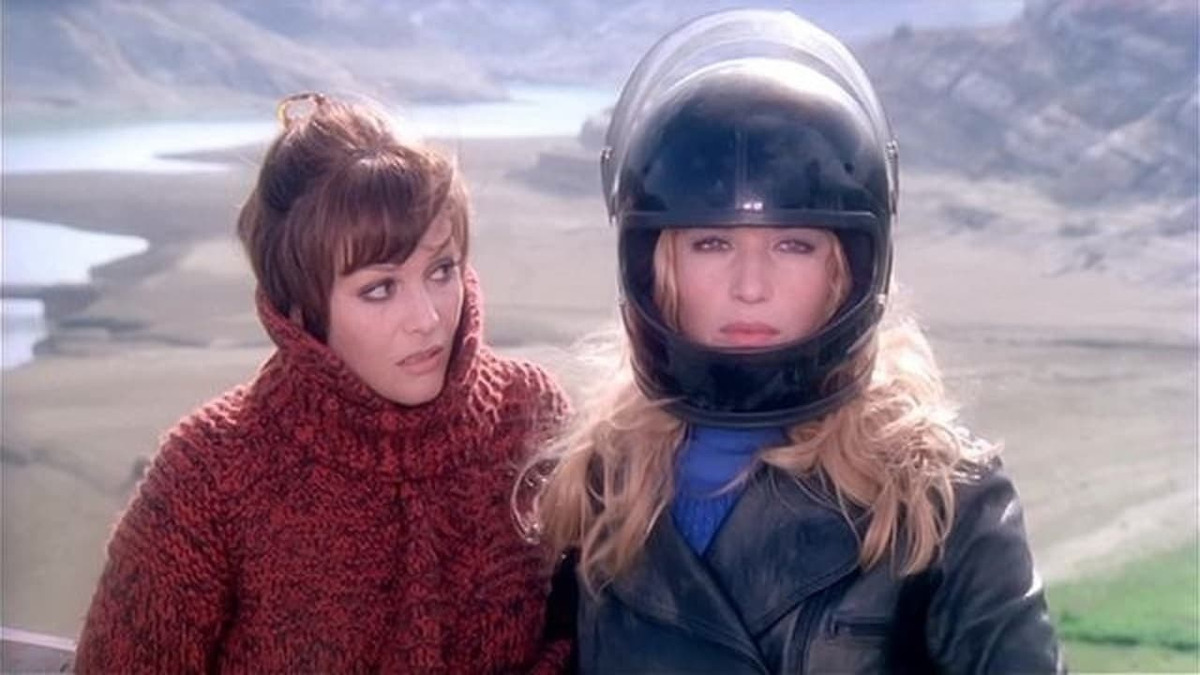preahvihearhotel.com – “Blonde in Black Leather” (original title: “La poliziotta fa carriera”), directed by Carlo Di Palma, is a lesser-known but intriguing entry in the genre of Italian commedia sexy all’italiana (Italian sex comedy). Released in 1975, the film blends humor, adventure, and feminist undertones, while showcasing the growing societal shifts in Italy during the 1970s. Featuring the talents of Monica Vitti and Claudine Auger, “Blonde in Black Leather” stands out as a quirky, spirited film that explores the liberation of women in both personal and professional spheres.
Plot Overview
The story follows Giovanna (Monica Vitti), a shy and frustrated Roman housewife stuck in a monotonous routine with her dull husband. Bored with her life, Giovanna dreams of excitement and escape. Her life takes a sudden turn when she meets Cristina (Claudine Auger), a glamorous and rebellious blonde dressed in black leather, who represents everything Giovanna desires—freedom, confidence, and danger.
Together, the two women embark on a wild adventure, stealing a motorcycle and hitting the road in a series of misadventures. As they ride through the Italian countryside, they become entangled in comic mishaps involving law enforcement, petty criminals, and various colorful characters. Throughout the journey, Giovanna learns to shed her inhibitions, finding her own identity and strength as she breaks free from societal expectations.
Feminism and Freedom: Themes of Female Empowerment
While “Blonde in Black Leather” operates within the realm of the Italian sex comedy, it goes beyond mere titillation to explore themes of female empowerment and independence. The film portrays a woman seeking liberation from the restrictive roles imposed by traditional Italian society—both in her personal life as a housewife and in the broader context of societal expectations for women.
Giovanna’s transformation from a timid housewife to a self-assertive woman represents a broader commentary on the shifting gender dynamics of 1970s Italy. Cristina’s character, with her bold leather outfits and carefree attitude, serves as the catalyst for this transformation, embodying the spirit of rebellion and autonomy. Through their friendship, the film challenges conventional depictions of women in cinema at the time, offering a fresh take on female bonding, self-discovery, and liberation.
A Unique Tone: Humor, Style, and Adventure
Director Carlo Di Palma, better known for his cinematography work on films like “Red Desert” (1964) and “Blow-Up” (1966), brings a distinctive visual flair to “Blonde in Black Leather.” His background as a cinematographer lends the film a polished aesthetic, with dynamic camera work and vibrant scenery that contrasts with the comedic chaos of the plot. The film combines the visual style of a road movie with slapstick humor and absurd scenarios, creating a lighthearted tone despite its underlying themes of freedom and rebellion.
The film’s pacing is fast, with plenty of action sequences, including motorcycle chases, escapes from the police, and humorous standoffs with various eccentric characters. This sense of adventure, paired with the film’s playful score, creates an entertaining blend of comedy and action.
Performances: Monica Vitti’s Comic Brilliance
Monica Vitti, known for her dramatic roles in Michelangelo Antonioni’s films, surprises audiences with her brilliant comedic timing in “Blonde in Black Leather.” Vitti brings a mix of vulnerability and wit to Giovanna, making her transformation from a submissive wife to an empowered woman both relatable and humorous. Her ability to balance comedy with moments of introspective growth adds depth to what could have been a purely superficial role.
Claudine Auger, famous for her role as a Bond girl in “Thunderball” (1965), is equally captivating as Cristina. Her portrayal of the wild and carefree woman who disrupts Giovanna’s life is full of charm and vitality. Together, Vitti and Auger share a chemistry that elevates the film, making their dynamic central to the narrative’s success.
Reception and Legacy
Although not as widely recognized as other Italian comedies of the era, “Blonde in Black Leather” has gained a cult following over the years, particularly among fans of 1970s cinema. Its blend of feminist themes, road movie adventure, and sharp comedy offers something unique within the Italian sex comedy genre. The film’s progressive take on female empowerment, coupled with Monica Vitti’s standout performance, makes it a notable entry in Italy’s cinematic landscape during a time of cultural change.
In the decades since its release, “Blonde in Black Leather” has come to be appreciated not only for its humor but also for its subtle commentary on the evolving roles of women in society. As a cult classic, the film remains a charming and entertaining look at the spirit of rebellion and self-discovery that defined the 1970s.
